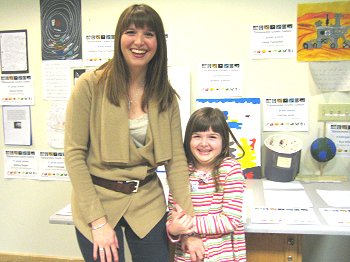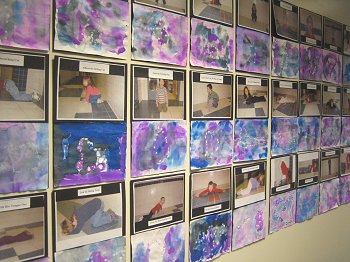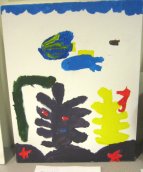- By Dan Veaner
- Around Town
 Print
Print
Excitement was in the air at the Sciencenter Saturday as Director of Education Rae Ostman announced the winners of the museum's Cosmic Contest. More than 1,300 children from Kindergarten through 5th grade submitted original artwork or essays on earth and space sciences. Lansing Elementary School's Kindergarten class was among the winners with a clever project in which children created their own constellations. And Lansing first grader Ashley Stanbro won for her drawing and brief story about coral reefs.
"Cosmic Contest built on our previously successful Science Minutes writing contest," says Rae Ostman, Sciencenter Director of Education. "With NASA/NY Space Grant Consortium at Cornell University contributing funds, the Sciencenter has provided a science writing contest to local children every year since 2000."

Lansing 1st Grader Ashley Stanbro with mom Laura Cima
standing in front of Ashley's winning 'Coral Reef' painting
The Lansing Kindergarten entry was the result of a collaborative effort between science teacher Sue Henne and art teacher Jessica Stratton, with help along the way from art substitute Betsy Galvin and third grade teacher Calvin Lange. Henne and Stratton developed the project, which involved research on constellations. Students chose a favorite animal, then posed for pictures of themselves as that animal. The children made dots around their pictures on transfer paper, which was then used to place the dots onto a sheet of paper they could paint on.
They used watercolors to paint the sky, and glow-in-the-dark paint for the stars. Each painting included the photo and the name of the constellation, based on the child's name, the animal and something the animal was doing. Constellations had such titles as, 'Sara the Lizard Watching for Danger,' 'Mena the Wiggling Snake,' 'Teresa the Cat Arching Its Back,' and 'Fiona the Crawling Caterpillar.'

"I loved watching them get animated in their photograph, and talk about what they liked about their animal," Henne says. "We talked about how constellations are basically arbitrary stories in the sky, and they created their own."
"Kids liked the glow in the dark paint," Stratton recalls. "We have large handicapped accessible bathrooms, and with little tiny Kindergarteners I can bring the entire class into them. It's the only part of the classroom that gets dark so I could show them that their creations would glow in the dark. They loved seeing that, and when they get to bring them home it will be in their bedroom and when the lights go out they'll be able to see their constellation. That was the wow factor for them."

Lansing Kindergarteners with their winning entries and teachers
(Left to right) Sue Henne, Jessica Stratton, and Carol Engels
Ashley Stanbro chose coral reefs as the topic for her entry. "If humans pollute the water it kills the coral, and then the sea creatures have no place to live," her paper reads. Her painting shows fish and other animals feeding in a coral reef. Ashley was present along with other students to receive her winning certificate and a $25 gift certificate to the Sciencenter store.
The Sciencenter has conducted a writing contest every year since 2000, funded by the NASA/NY Space Grant Consortium at Cornell University. This year's contest invited children in grades K-2 to create original artwork showing an aspect of earth or space sciences, with a caption or short story explaining their work. Older children submitted a brief essay on those topics. Three judges reviewed every entry at least twice. Ostman says it took judges three days to view all the entries and make their final choices. Entries came from Ithaca, Candor, Elmira City, Groton, Odessa-Montour, Lansing, South Seneca, Trumansburg, and Virgil.
 The winners from several schools were announced at the end of a presentation about the birth of the universe conducted by Cornell University graduate student Sabrina Stierwalt. Stierwalt demonstrated how the universe is expanding using balloons. Each child was told to use a marker to put dots, representing stars, on their balloons. When they blew up the balloons, the dots moved farther apart, showing how stars become more distant as the universe expands.
The winners from several schools were announced at the end of a presentation about the birth of the universe conducted by Cornell University graduate student Sabrina Stierwalt. Stierwalt demonstrated how the universe is expanding using balloons. Each child was told to use a marker to put dots, representing stars, on their balloons. When they blew up the balloons, the dots moved farther apart, showing how stars become more distant as the universe expands.
"My favorite part of reviewing the Cosmic Contest entries was the kids' creativity," Ostman says. "We left the guidelines fairly loose and flexible, and that left kids with a lot of room to be creative in expressing what they learned. Our artwork entries included drawings, paintings, storyboards, and three-dimensional sculptures. Written works included essays, mock talk-show scripts, and personal reflections. My second-favorite part of reviewing the entries was learning a lot about the earth and space sciences from the kids!"
"My favorite part of the contest was the number of people who were inspired to get interested and learn more about space," adds Education Program Manager Shannon McSurely.
Stratton and Henne say that the Kindergarten certificate will be put on display in their school. Additionally students who entered the contest each received a Sciencenter pass. "With out Lansing budget the way it is, our Kindergarten teams have elected to use those for a field trip," Stratton says. "We'll be able to come to the museum and spend a whole afternoon."
----
v4i10
"Cosmic Contest built on our previously successful Science Minutes writing contest," says Rae Ostman, Sciencenter Director of Education. "With NASA/NY Space Grant Consortium at Cornell University contributing funds, the Sciencenter has provided a science writing contest to local children every year since 2000."

Lansing 1st Grader Ashley Stanbro with mom Laura Cima
standing in front of Ashley's winning 'Coral Reef' painting
The Lansing Kindergarten entry was the result of a collaborative effort between science teacher Sue Henne and art teacher Jessica Stratton, with help along the way from art substitute Betsy Galvin and third grade teacher Calvin Lange. Henne and Stratton developed the project, which involved research on constellations. Students chose a favorite animal, then posed for pictures of themselves as that animal. The children made dots around their pictures on transfer paper, which was then used to place the dots onto a sheet of paper they could paint on.
They used watercolors to paint the sky, and glow-in-the-dark paint for the stars. Each painting included the photo and the name of the constellation, based on the child's name, the animal and something the animal was doing. Constellations had such titles as, 'Sara the Lizard Watching for Danger,' 'Mena the Wiggling Snake,' 'Teresa the Cat Arching Its Back,' and 'Fiona the Crawling Caterpillar.'

"I loved watching them get animated in their photograph, and talk about what they liked about their animal," Henne says. "We talked about how constellations are basically arbitrary stories in the sky, and they created their own."
"Kids liked the glow in the dark paint," Stratton recalls. "We have large handicapped accessible bathrooms, and with little tiny Kindergarteners I can bring the entire class into them. It's the only part of the classroom that gets dark so I could show them that their creations would glow in the dark. They loved seeing that, and when they get to bring them home it will be in their bedroom and when the lights go out they'll be able to see their constellation. That was the wow factor for them."

Lansing Kindergarteners with their winning entries and teachers
(Left to right) Sue Henne, Jessica Stratton, and Carol Engels
Ashley Stanbro chose coral reefs as the topic for her entry. "If humans pollute the water it kills the coral, and then the sea creatures have no place to live," her paper reads. Her painting shows fish and other animals feeding in a coral reef. Ashley was present along with other students to receive her winning certificate and a $25 gift certificate to the Sciencenter store.
The Sciencenter has conducted a writing contest every year since 2000, funded by the NASA/NY Space Grant Consortium at Cornell University. This year's contest invited children in grades K-2 to create original artwork showing an aspect of earth or space sciences, with a caption or short story explaining their work. Older children submitted a brief essay on those topics. Three judges reviewed every entry at least twice. Ostman says it took judges three days to view all the entries and make their final choices. Entries came from Ithaca, Candor, Elmira City, Groton, Odessa-Montour, Lansing, South Seneca, Trumansburg, and Virgil.

Coral Reef by Ashley Stanbro
"My favorite part of reviewing the Cosmic Contest entries was the kids' creativity," Ostman says. "We left the guidelines fairly loose and flexible, and that left kids with a lot of room to be creative in expressing what they learned. Our artwork entries included drawings, paintings, storyboards, and three-dimensional sculptures. Written works included essays, mock talk-show scripts, and personal reflections. My second-favorite part of reviewing the entries was learning a lot about the earth and space sciences from the kids!"
"My favorite part of the contest was the number of people who were inspired to get interested and learn more about space," adds Education Program Manager Shannon McSurely.
Stratton and Henne say that the Kindergarten certificate will be put on display in their school. Additionally students who entered the contest each received a Sciencenter pass. "With out Lansing budget the way it is, our Kindergarten teams have elected to use those for a field trip," Stratton says. "We'll be able to come to the museum and spend a whole afternoon."
----
v4i10



